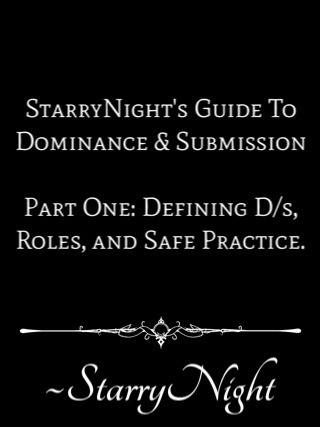thesweetertouchofdominance: defiantly-yourss: onceuponsirsstarrynight:What is Dominance and Submis
thesweetertouchofdominance: defiantly-yourss: onceuponsirsstarrynight: What is Dominance and Submission Dominance and submission (abbreviated D/s) is one subset of the broader BDSM subculture, and while there are many misconceptions within western society about what BDSM truly is, it’s something that has seen an explosion in popularity within mainstream culture thanks to the commercial success of books such as Fifty Shades of Grey series and the rise of the internet. That commercial popularity has led to significant advances in social acceptance and the destigmatization, both good things, but it has also ushered in an unprecedented amount of misinformation. While a fundamental inability to grasp what BDSM truly is in vanilla society is forgivable, what’s truly shocking is how grossly misunderstood BDSM is not just amongst the vanilla, but the kinky themselves. I believe that the roots of that misunderstanding stem from beliefs that are rooted in BDSM fantasy: whether it’s the dungeons of the middle ages, or the image of the taking of slaves as the spoils of war, or torment and humiliation of the weak. And while no great discussion of BDSM – or dominance and submission - would be complete without a deep dive into it’s decidedly non-consensual ancient heritage, for today’s purposes we’ll be discussing dominance and submission in it’s contemporary form and, hopefully, shattering a few misconceptions while providing guidance and perspective. With that being said, let’s begin the process of providing clarity about what D/s is, and what it is not. We’ll start with the acronym itself. BDSM is a three part acronym combining three separate abbreviations into one, they are as follows: (BD) Bondage and Discipline (DS) Dominance and Submission (SM) Sadism and Masochism While these three abbreviations fit nicely together, there is no need to think of them as separate entities: how you choose to engage in BDSM is entirely at your discretion, and as you’ll hear from anyone with enough experience, there is no right or wrong way to go about it. For this exercise though, let us focus primarily on dominance and submission. At it’s core, dominance and submission is about power exchange. Power exchange within the context of dominance and submission is a consensual, mutually agreed to, negotiated, and codified relationship wherein one party voluntarily requests to be led by another. In this relationship, the person giving power is referred to as the submissive, and the one agreeing to accept the responsibility of power is known as the dominant. The scope of that exchange of power is something that is entirely within the purview of it’s practitioners, but fundamentally it is critical to understand that DOMINANCE AND SUBMISSION IS NOT ABOUT SEX. This is something that is absolutely critical to understand. For some this may seem surprising since many people’s preconceived notions of what D/s is are almost always sex-centric. Before they actually engage in the lifestyle, many (most?) people are under the impression that dominance and submission is all about rough sex, sadomasochism, slavery, and bondage. While all of those things may or may not be present within a D/s relationship, that is not what D/s itself, is. Rather, dominance and submission is about establishing the rules, roles, and methodologies of engagement that will define that couples interactions. When I attempt to explain dominance and submission to those who are not involved in BDSM I let them know that dominance and submission is nothing more than a normal relationship in which the parties engage in active, continual communication, establishing the rules and roles each party is obligated to fulfill. They fulfill those roles in order to ensure each parties mutual happiness, with one party accepting the responsibility of leadership and ensuring that both parties adhere to their negotiated, and consented roles. That’s it. Dominance and submission need not have anything to do with sex, whips or chains, rope or pain, leather or latex. It is simply a method of engaging in a relationship – how you choose to dress that up is entirely up to you and your partners wants and needs. For some that may mean sacrificing control over certain parts of what happens in their sex life, for others it may include sadomasochism, for others it may be entirely relationship based with little, or even no correlation at all to what happens in the bedroom. The permutations of how a couple could choose to practice are as infinite as the universe, and every bit as diverse. There are however some basic tenets that those in the lifestyle operate under, namely what we call Safe, Sane, and Consensual – or SSC. Safe: Meaning that however you choose to practice, no matter how extreme it may be, should be done safely. There are so many things that can be done in our lifestyle that, if not practiced safely, by people well trained in their application, can lead to devastating injury, emotional damage, or yes, even death. While you’re under no obligation to practice anything outside of your comfort zone (your limits), know that if you choose to do so, you should only be engaging in their practice with people you know are well trained, and whom you trust explicitly. Even seemingly benign this like rope bondage or nipple clamps can lead to injury due to loss of circulation. Before you ever engage in any activity, invest yourself into your education, and ensure your partner is as well. Safety is everyone’s responsibility, not just yours. Sane: Meaning that the things you do should pass a basic common sense test. If something seems wildly outlandish, it probably is. Keep in mind that much of what you see in BDSM pornography is fantasy. It is something that was intentionally designed, and set for that purpose. Public sex may seem exciting, but if there are kids around (or even other adults) don’t do it. Consensual non-consent (rape fantasy) may seem exciting and intriguing, and for some it is, but keep in mind that for many, many others it’s a brutally painful trigger for past trauma. Consensual: Meaning that every single thing you do must be negotiated and agreed to first. In our lifestyle this is paramount, and I’m a firm believer that everyone who chooses to engage in BDSM should first obtain Affirmative Consent: meaning that only YES means YES, and everything else means NO. It’s also important to reiterate what should be obvious, people with mental handicaps and those who are under the influence of drugs or alcohol cannot provide affirmative consent. It does not matter if they’ve been your partner for a decade, if they’ve been drinking, their ability to give consent, and more importantly, their ability to properly parse what’s happening to them and protect themselves by “safewording” is impaired, and that’s no way to practice with someone you should love and care for. What Dominance and Submission IS NOT Dominance and submission is not a cover for abuse, or rape. Dominance and submission is predicated on negotiated relationships between consenting adults. The only time in which physical interaction of any sort is allowed is when both parties have made it explicitly clear to the other that that is what they want. If the person you choose to engage with is making you feel uncomfortable, or trying to get you to agree to things that you don’t want to do, or making you feel worse about yourself run, don’t walk, from that situation and make others aware of that persons behavior immediately. If you’re looking to take on the role of dominant understand that you are not a dominant to any submissive until she has consented to a very exact, very well defined scope of power exchange. Until then, they are to be treated with absolute respect. If you wouldn’t talk to the person you respect most in life that way, don’t talk to a submissive that way. Dominance and submission isn’t about cheap, easy, no-strings attached sex: It is a deeply intimate relationship between two (or more) people who have taken the time to know one another on an extremely intimate level and who have developed deep bonds of trust and respect that allow them to explore incredible, and sometimes dangerous or emotionally sensitive aspects of their lives. What is a submissive? The term submissive alone is enough to make some people’s skin crawl as it conjurs images of someone who is weak-willed, timid, cowardly, enslaved, or abused. Thankfully as I’ll try and highlight, that image of the fading man or woman couldn’t (usually) be further from the truth. Indeed, most submissives tend to be exceptionally strong willed people who are perfectly capable of being assertive, and they are equally as likely to be as intelligent and capable as their dominant partners. Most submissives are highly competent at their chosen professions and they’re every bit as likely to be well educated as the next person. A submissive is not someone who is weak, on the contrary, more often than not they are abundantly powerful people in their everyday lives - they are simply someone who enjoys being the one to take on the role of follower in their personal relationship. Perhaps they want the FREEDOM to not have to lead for once in their lives. They may passionately desire that instead of being the one who must make all the decisions, that they’ll have a strong, intelligent, loving, and capable partner whom they can entrust to handle that decision making for them. Submissive is also a blanket term for a wide variety of sub-categories of submission, the four most prominent being: Bottoms: Those who serve in the submissive role during BDSM sceens. They agree to negotiate a degree of power exchange before consenting to the interaction(s), and maintain the right to renegotiate that agreement at any time. Littles: This is far and away the most critically misunderstood of all the submissive subcategories, both by those on the outside looking in, and those who actually identify as littles. But critically, they are those who enjoy a relationship with more of a parent/child dynamic than the adult-adult that exists within the standard D/s dynamic. Typically the little is defined by having child-like tendencies. IE: enjoying time to color, play at the park, sleeping with and playing with stuffed animals, etc… While they can function within adult society, they very much act the part of the child - because internally they identify as a child. While the little may enjoy other forms of play such as age-play, ABDL (adult baby, diaper lover), incest play, these are NOT prerequisites to the dynamic. They agree to negotiate a degree of power exchange before consenting to the relationship, and maintain the right to renegotiate that agreement at any time. This article is highly recommended reading from The Submissive Guide with some little-to-little wisdom for those who think they may be a little. Submissive: Someone who enjoys being in a relationship in which they freely consent to give some degree of power to their dominant. They agree to negotiate a degree of power exchange before consenting to the relationship, and maintain the right to renegotiate that agreement at any time. They are a partner, not a slave. Slave: A slave differentiates themselves from standard submission in that they are agreeing to total (or near total) power exchange. They still retain the rights to safeword and leave the relationship (they are not true slaves) but they voluntarily give up the right to renegotiate their agreement once it’s been agreed to. That doesn’t mean the agreement can’t or won’t be amended, but that it’s at the discretion of the dominant party.What is a dominant? A dominant is the counter-point to the submissive, and the one who accepts responsibility for their relationship. They are not infallible or all-knowing, they are not the sole proprietors of truth and wisdom, or emotionless automatons. They are entrusted with ensuring that the mutual happiness of both parties is attended to, both by upholding their role within the dynamic, and ensuring that their submissive partner fulfills their role. They agree to take on the burden of leading the relationship and assume responsibility for the ultimate success, or failure of that relationship. Their chief role is not to be the whip-wielding slave driver (though some couples may enjoy that) but rather to be the one who leads by providing everything their agreement outlines. They are responsible for developing and maintaining a safe, secure, nurturing, loving environment, replete with strong communication, and adherence to their agreement. Just as is the case with submissives, ‘dominant’ is a blanket term for a wide variety of dominant sub-categories, the four most prominent being: Top: The top is the counter-point to the bottom. They are responsible for the safety and protection of the bottom with whom they’ll be screening, and ensuring that the agreements they’ve made are adhered to. Daddy/Mommy: A daddy or mommy is the counter-point to the little. Like any dominant they are responsible for the care, nurturing, guidance, growth, safety, love and discipline of their little. Additionally, they may also be responsible for setting bedtimes, cooking meals, ensuring their littles get playtime, etc… They assume the parental role and ensure that the couples negotiated agreement is fulfilled and that each parties wants and needs are met. Dominant: A dominant is the counter-point to the submissive. They are responsible for the care, nurturing, guidance, growth, safety, love and discipline of their submissive. They assume the leadership role and ensure that the couples negotiated agreement is fulfilled and that each parties wants and needs are met. Master/Mistress: A master or mistress is the counter-point to the slave. They are responsible for the care, nurturing, guidance, growth, safety, love and discipline of their slave. They assume the leadership role and ensure that the couples negotiated agreement is fulfilled and that each parties wants and needs are met. In Summation Just as is the case with submissives, dominants can assume more than one role, and operate on a spectrum. A master could be called daddy (instead of the more typical title of master), and he could be very soft, tender, and nurturing toward his slave. Conversely, a mommy could be called mistress and be very harsh and strict with her little boy. It’s important to understand that every dynamic is unique, and that there is not “right” or “wrong” way to engage in dominance and submission - it’s about finding two (or more) people who agree to a dynamic that makes them happy and fulfills their needs. Is Dominance & Submission For Me? I’m a firm believer that dominance and submission could be for anyone who has longed for something more than their previous relationship. One of the most frequent comments I’ve heard from both men and women in their life is that they feel like they’re partner has forgotten about them or, “stopped trying.” They feel neglected in their relationship. Dominance and submission, with it’s requirements for open communication, negotiation, and (hopefully) written agreements provides a potential solution to that. It seems silly to say, but when each party can go back to their agreement and say, “see, you promised that you would do X for me,” it provides a solution for holding people accountable to meeting one another’s needs. For the woman who says, “you promised me you wouldn’t stop taking me on dates, but we haven’t been on one in two months,” or the guy who says, “I told you I needed to have sex at least once a day, but we haven’t had sex in weeks…” pre-negotiated, codified agreements present a potential solution. What you choose to agree upon could be literally anything you can imagine. It could be physical, emotional, psychological, financial… you name it. Of course with dominance and submission being part of the broader BDSM subculture, it also typically involves kink (and lots of it!). That’s because the confidence and trust we can develop in a relationship of this nature is boundless, and it is that trust, and that confidence that provides us with the security to open ourselves up and expose our true nature, our hidden desires, and our darkest fantasies to a partner we know is completely invested in our happiness, our safety, and our fulfillment. It’s important to understand however that relationships that require deep trust, also require phenomenal communication, and leaders of the absolute highest character. The sort that is born of both emotionally honesty, and emotional vulnerability. It requires partners that are emotionally intelligent enough to be deeply and keenly sensitive to their partners emotional needs as well as their own. This is not for the immature, and it is not for the reckless. It’s important that you understand what you’re getting into, and the very serious responsibility that you’re agreeing to take on. But if you’ve spent your life unfulfilled and you’re looking for something more out of your relationships, D/s might just provide the answer. Lovely writing! You hit tons of super important points. Anyone new to bdsm or anyone for that matter should read this ☺️ A great explanation! -- source link
Tumblr Blog : onceuponsirsstarrynight.tumblr.com



